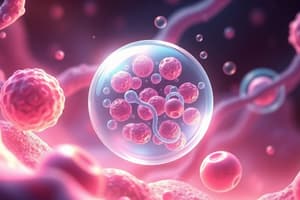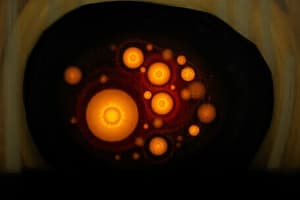Podcast
Questions and Answers
Where are ribosomal subunits synthesized?
Where are ribosomal subunits synthesized?
- ER
- Nucleus (correct)
- Mitochondria
- Cytoplasm
What is the main function of ribosomes?
What is the main function of ribosomes?
- Initiating apoptosis
- Synthesizing lipids
- Protein synthesis (correct)
- Producing blood proteins
What organelle is referred to as the 'powerhouse' of the cell?
What organelle is referred to as the 'powerhouse' of the cell?
- Nucleus
- Mitochondria (correct)
- Ribosomes
- Endoplasmic Reticulum
Which organelle plays an important role in apoptosis by releasing cytochrome c?
Which organelle plays an important role in apoptosis by releasing cytochrome c?
Where do ribosomal subunits pass to after being formed in the nucleus?
Where do ribosomal subunits pass to after being formed in the nucleus?
Which organelle is an interconnected network of tubules, vesicles, and cisternae?
Which organelle is an interconnected network of tubules, vesicles, and cisternae?
What is the function of the plasma membrane in a cell?
What is the function of the plasma membrane in a cell?
Which component makes up 45% of the cell membrane?
Which component makes up 45% of the cell membrane?
What is the function of the nucleus in a cell?
What is the function of the nucleus in a cell?
What is the composition of the cell membrane mainly made of?
What is the composition of the cell membrane mainly made of?
Which part of a phospholipid molecule is hydrophilic?
Which part of a phospholipid molecule is hydrophilic?
What is the function of organelles in a cell?
What is the function of organelles in a cell?
What is the function of lysosomes in a cell?
What is the function of lysosomes in a cell?
Which cell types are likely to have abundant lysosomes?
Which cell types are likely to have abundant lysosomes?
During autophagy, what cellular components do lysosomes help break down?
During autophagy, what cellular components do lysosomes help break down?
Which organelle is known as the 'digestive system of the cell'?
Which organelle is known as the 'digestive system of the cell'?
What happens to cells during the process of atrophy?
What happens to cells during the process of atrophy?
Why are lysosomes sometimes referred to as 'cellular garbage disposals'?
Why are lysosomes sometimes referred to as 'cellular garbage disposals'?
What is the function of cholesterol in the plasma membrane?
What is the function of cholesterol in the plasma membrane?
Which type of membrane proteins extend through the entire thickness of the membrane?
Which type of membrane proteins extend through the entire thickness of the membrane?
What makes the tail of the membrane hydrophobic?
What makes the tail of the membrane hydrophobic?
Which function do membrane proteins NOT perform?
Which function do membrane proteins NOT perform?
How do peripheral proteins differ from integral proteins?
How do peripheral proteins differ from integral proteins?
What is the role of linker proteins in the cell membrane?
What is the role of linker proteins in the cell membrane?
Which organelle is prominent in cells specialized for protein secretion?
Which organelle is prominent in cells specialized for protein secretion?
What is the function of smooth endoplasmic reticulum (SER) in liver cells?
What is the function of smooth endoplasmic reticulum (SER) in liver cells?
What is the main function of the Golgi apparatus in secretory cells?
What is the main function of the Golgi apparatus in secretory cells?
Which organelle is rich in steroid hormone–producing cells of the adrenal cortex?
Which organelle is rich in steroid hormone–producing cells of the adrenal cortex?
In muscle cells, which organelle is involved in the release and recapture of calcium ions for contraction and relaxation?
In muscle cells, which organelle is involved in the release and recapture of calcium ions for contraction and relaxation?
What distinguishes rough endoplasmic reticulum (RER) from smooth endoplasmic reticulum (SER) at a structural level?
What distinguishes rough endoplasmic reticulum (RER) from smooth endoplasmic reticulum (SER) at a structural level?
Flashcards are hidden until you start studying
Study Notes
Ribosomal Subunits and Ribosomes
- Ribosomal subunits are synthesized in the nucleolus of the nucleus.
- The main function of ribosomes is to facilitate protein synthesis by translating messenger RNA (mRNA) into polypeptide chains.
Energy and Apoptosis
- The mitochondrion is referred to as the 'powerhouse' of the cell due to its role in ATP production through cellular respiration.
- Mitochondria play a key role in apoptosis by releasing cytochrome c, which activates the apoptotic pathway.
Cellular Structures and Functions
- Ribosomal subunits pass from the nucleus to the cytoplasm after being formed, where they assemble with mRNA and tRNA to synthesize proteins.
- The endoplasmic reticulum (ER) is an interconnected network of tubules, vesicles, and cisternae involved in protein and lipid synthesis.
- The plasma membrane functions as a protective barrier that regulates the movement of substances in and out of the cell.
Cell Membrane Composition
- Phospholipids make up approximately 45% of the cell membrane structure.
- The cell membrane is primarily composed of a phospholipid bilayer, along with proteins, cholesterol, and carbohydrates.
Phospholipids
- The hydrophilic (water-attracting) part of a phospholipid molecule is the phosphate group.
- The hydrophobic (water-repelling) tail of the membrane is made up of fatty acid chains.
Organelle Functions
- Organelles in a cell serve specific functions, including energy production, protein synthesis, and waste disposal.
- Lysosomes function as the 'digestive system of the cell,' breaking down waste material and cellular debris.
Lysosomes and Cellular Maintenance
- Cells with high metabolic activity, such as macrophages and certain glandular cells, are likely to have abundant lysosomes.
- During autophagy, lysosomes help break down damaged organelles, misfolded proteins, and other cellular components.
- Lysosomes are sometimes referred to as 'cellular garbage disposals' because they digest and remove waste from the cell.
Membrane Components and Proteins
- Cholesterol maintains the fluidity and stability of the plasma membrane.
- Integral membrane proteins extend through the entire thickness of the membrane, while peripheral proteins are attached to the surface.
Membrane Structure and Function
- The hydrophobic tail of membrane phospholipids prevents the free passage of water-soluble substances.
- Membrane proteins do not directly perform energy production; their roles include transport, signaling, and structural support.
- Peripheral proteins differ from integral proteins as they are not embedded within the lipid bilayer.
Role of Linker Proteins
- Linker proteins in the cell membrane connect cytoskeletal elements to membrane proteins, contributing to cell shape and structure.
Specialized Cellular Structures
- The rough endoplasmic reticulum (RER) is prominent in cells that specialize in protein secretion, characterized by ribosomes on its surface.
- The smooth endoplasmic reticulum (SER) in liver cells functions in the detoxification of drugs and the metabolism of carbohydrates and lipids.
- The Golgi apparatus is essential for modifying, sorting, and packaging proteins for secretion in secretory cells.
Calcium Management in Muscle Cells
- In muscle cells, the sarcoplasmic reticulum is responsible for the release and recapture of calcium ions, crucial for muscle contraction and relaxation.
Structural Differences in ER
- Rough endoplasmic reticulum (RER) has ribosomes attached to its cytoplasmic surface, making it appear 'rough' under a microscope, while smooth endoplasmic reticulum (SER) lacks these ribosomes and appears smooth.
Studying That Suits You
Use AI to generate personalized quizzes and flashcards to suit your learning preferences.




